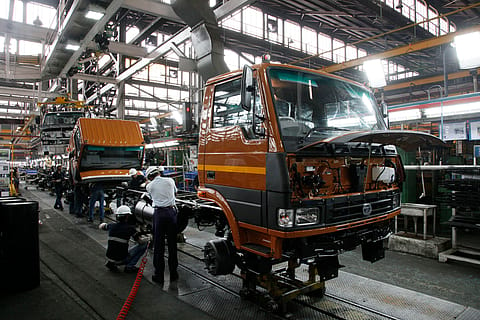Tata Motors to begin new innings as a commercial vehicles company, again
Tata Motors, which previously housed commercial and passenger vehicles under one roof, will begin trading as two independently listed companies.

The commercial vehicles arm of Tata Motors will commence trading as a standalone commercial vehicle maker from November 12. It will be the culmination of the demerger exercise, which came into effect on October 1, separating Tata Motors’ commercial vehicle business from its passenger vehicle arm.
Girish Wagh, who leads the commercial vehicles arm of Tata Motors, joined the board of TML Commercial Vehicles as an additional director, managing director and CEO, effective October 1.
According to the demerger terms, for each share held in the combined company, shareholders will receive a share of Tata Motors Commercial Vehicles—a share entitlement ratio of 1:1—on the record date, October 14. The demerger proposal had received overwhelming shareholder support—with 99.9995% of the shareholders voting in favour of the proposal. According to Tata Motors chairman N Chandrasekaran, the demerger would bring greater strategic clarity and agility, enabling a more focused approach to execution and value creation, delivering long-term returns for shareholders.
In March 2024, Tata Motors’ board approved a proposal to demerge the automaker into two separate listed companies—one housing its commercial vehicles business and the other its passenger vehicles business, including electric vehicles (EVs) and the British marque Jaguar Land Rover (JLR). The demerger will be implemented through a scheme of arrangement under the National Company Law Tribunal (NCLT), and all shareholders of Tata Motors will continue to hold the same shareholding in both listed entities.
Over the past few years, the commercial vehicles (CV), passenger vehicles (PV+EV), and Jaguar Land Rover (JLR) businesses of Tata Motors have been operating independently under their respective CEOs. The demerger is a logical progression of the earlier subsidiarisation of PV and EV businesses in 2022, the automaker said last year.
While there are limited synergies between CV and PV businesses, considerable synergies can be harnessed across PV, EV, and JLR, particularly in areas such as EVs, autonomous vehicles, and vehicle software.
Roots of a commercial vehicle maker
While the operations of Tata Motors span commercial and passenger vehicles—including electric vehicles and Jaguar Land Rover—Tata Motors, previously known as TELCO, began life in a newly independent India as a maker of locomotives, before foraying into commercial vehicles. In 1945, TELCO began as a manufacturer of locomotives, then, in 1948, entered into a collaboration with Marshall Sons (UK) to produce steam road rollers.
Recommended Stories
In 1954, TELCO launched its first commercial vehicle, the TMB 312 truck, in collaboration with Mercedes-Benz. In 1975, the first set of Tata 1210 semi-forward model was rolled out on Indian roads. By 1983, TELCO had begun manufacturing heavy commercial vehicles, whereas the first light commercial vehicle—the Tata LCV 407—was launched in 1986. By 1989, the company had launched its first multi-utility vehicle. It was only by 1991, TELCO had launched the Sierra, its first indigenous passenger vehicle, which it plans to relaunch later in November in both ICE and electric variants.
By 2004, TELCO, in collaboration with Daewoo, had launched the Tata NOVUS. In 2005, it launched the highly successful ‘Globus’ and ‘Starbus’ ranges of fully-built buses and coaches, and the Tata Ace, India’s first mini truck.
In FY25, the commercial vehicle business of Tata Motors recorded an annual revenue of ₹75,055 crore, a 17% share in the consolidated revenue. Despite a year of varying demand and marginal decline in sales volumes, its EBIT reached an all-time high of ₹6,794 crore, representing a 4.9% growth over FY24.
According to data from the Federation of Automobile Dealers Associations (FADA), Tata Motors was the largest commercial vehicle OEM in the country in FY25, cornering a 48.46% market share, and retailing 4,286 units. It was, however, far below the 5,598 units it sold in FY24, when it had a 65.91% market share.
Future: expansion to Europe and beyond
In July, Tata Motors reached an agreement with Italy’s Iveco to acquire its trucking business for a deal that values Iveco’s trucking business at about €3.8 billion, making it the biggest acquisition by deal size the homegrown maker of passenger and commercial vehicles has done, surpassing the $2.23 billion it paid for acquiring Jaguar Land Rover in 2008.
“This is a logical next step following the demerger of the Tata Motors Commercial Vehicle business and will allow the combined group to compete on a truly global basis with two strategic home markets in India and Europe,” Natarajan Chandrasekaran, chairman, Tata Motors, had said in a statement, adding that the combined group’s complementary businesses and greater reach will “enhance our ability to invest boldly.”
